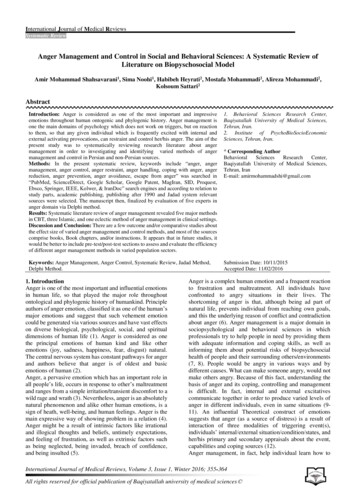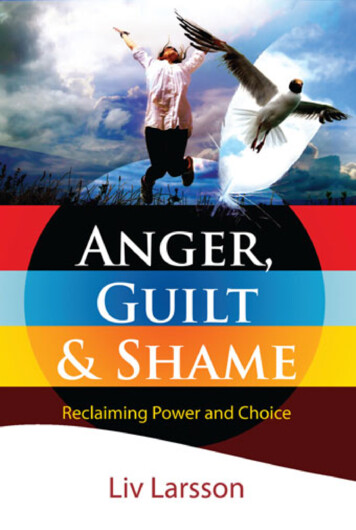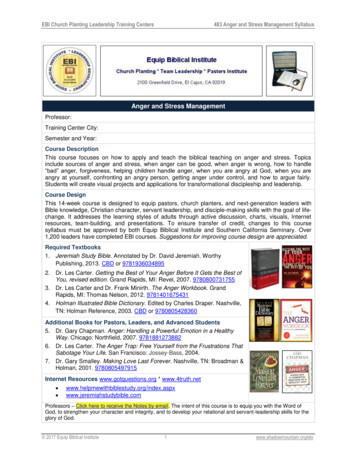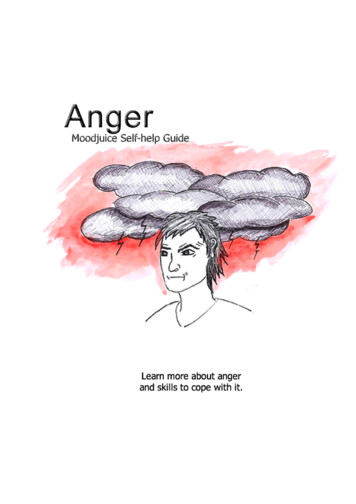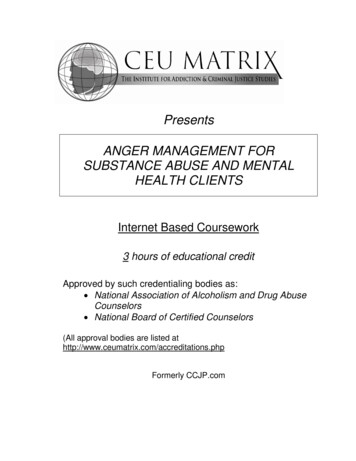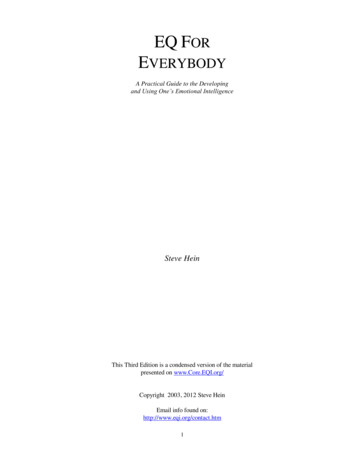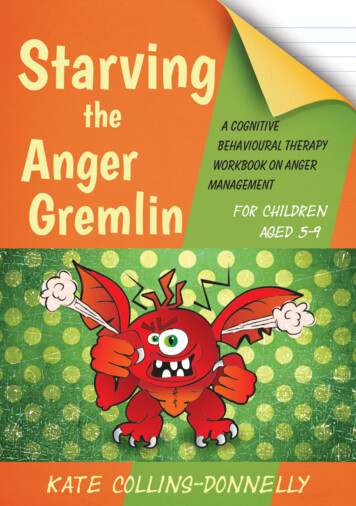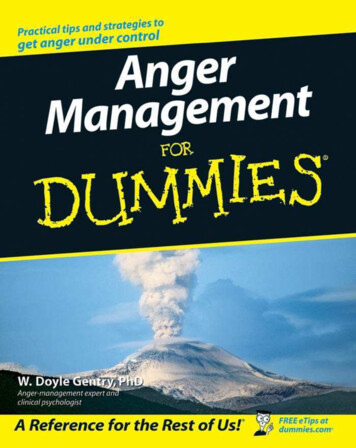
Transcription
AngerManagementFORDUMmIESby W. Doyle Gentry, PhD‰
Anger Management For Dummies Published byWiley Publishing, Inc.111 River St.Hoboken, NJ 07030-5774www.wiley.comCopyright 2007 by Wiley Publishing, Inc., Indianapolis, IndianaPublished simultaneously in CanadaNo part of this publication may be reproduced, stored in a retrieval system, or transmitted in any form orby any means, electronic, mechanical, photocopying, recording, scanning, or otherwise, except as permitted under Sections 107 or 108 of the 1976 United States Copyright Act, without either the prior writtenpermission of the Publisher, or authorization through payment of the appropriate per-copy fee to theCopyright Clearance Center, 222 Rosewood Drive, Danvers, MA 01923, 978-750-8400, fax 978-646-8600.Requests to the Publisher for permission should be addressed to the Legal Department, Wiley Publishing,Inc., 10475 Crosspoint Blvd., Indianapolis, IN 46256, 317-572-3447, fax 317-572-4355, or online athttp://www.wiley.com/go/permissions.Trademarks: Wiley, the Wiley Publishing logo, For Dummies, the Dummies Man logo, A Reference for theRest of Us!, The Dummies Way, Dummies Daily, The Fun and Easy Way, Dummies.com and related tradedress are trademarks or registered trademarks of John Wiley & Sons, Inc. and/or its affiliates in the UnitedStates and other countries, and may not be used without written permission. All other trademarks are theproperty of their respective owners. Wiley Publishing, Inc., is not associated with any product or vendormentioned in this book.LIMIT OF LIABILITY/DISCLAIMER OF WARRANTY: THE CONTENTS OF THIS WORK ARE INTENDED TOFURTHER GENERAL SCIENTIFIC RESEARCH, UNDERSTANDING, AND DISCUSSION ONLY AND ARE NOTINTENDED AND SHOULD NOT BE RELIED UPON AS RECOMMENDING OR PROMOTING A SPECIFICMETHOD, DIAGNOSIS, OR TREATMENT BY PHYSICIANS FOR ANY PARTICULAR PATIENT. THE PUBLISHER AND THE AUTHOR MAKE NO REPRESENTATIONS OR WARRANTIES WITH RESPECT TO THEACCURACY OR COMPLETENESS OF THE CONTENTS OF THIS WORK AND SPECIFICALLY DISCLAIM ALLWARRANTIES, INCLUDING WITHOUT LIMITATION ANY IMPLIED WARRANTIES OF FITNESS FOR A PARTICULAR PURPOSE. IN VIEW OF ONGOING RESEARCH, EQUIPMENT MODIFICATIONS, CHANGES INGOVERNMENTAL REGULATIONS, AND THE CONSTANT FLOW OF INFORMATION RELATING TO THE USEOF MEDICINES, EQUIPMENT, AND DEVICES, THE READER IS URGED TO REVIEW AND EVALUATE THEINFORMATION PROVIDED IN THE PACKAGE INSERT OR INSTRUCTIONS FOR EACH MEDICINE, EQUIPMENT, OR DEVICE FOR, AMONG OTHER THINGS, ANY CHANGES IN THE INSTRUCTIONS OR INDICATION OF USAGE AND FOR ADDED WARNINGS AND PRECAUTIONS. READERS SHOULD CONSULT WITHA SPECIALIST WHERE APPROPRIATE. THE FACT THAT AN ORGANIZATION OR WEBSITE IS REFERREDTO IN THIS WORK AS A CITATION AND/OR A POTENTIAL SOURCE OF FURTHER INFORMATION DOESNOT MEAN THAT THE AUTHOR OR THE PUBLISHER ENDORSES THE INFORMATION THE ORGANIZATION OR WEBSITE MAY PROVIDE OR RECOMMENDATIONS IT MAY MAKE. FURTHER, READERS SHOULDBE AWARE THAT INTERNET WEBSITES LISTED IN THIS WORK MAY HAVE CHANGED OR DISAPPEAREDBETWEEN WHEN THIS WORK WAS WRITTEN AND WHEN IT IS READ. NO WARRANTY MAY BE CREATED OR EXTENDED BY ANY PROMOTIONAL STATEMENTS FOR THIS WORK. NEITHER THE PUBLISHERNOR THE AUTHOR SHALL BE LIABLE FOR ANY DAMAGES ARISING HEREFROM.For general information on our other products and services, please contact our Customer CareDepartment within the U.S. at 800-762-2974, outside the U.S. at 317-572-3993, or fax 317-572-4002.For technical support, please visit www.wiley.com/techsupport.Wiley also publishes its books in a variety of electronic formats. Some content that appears in print maynot be available in electronic books.Library of Congress Control Number: 2006934834ISBN-13: 978-0-470-03715-7ISBN-10: 0-470-03715-6Manufactured in the United States of America10 9 8 7 6 5 4 3 2 11B/RX/RR/QW/IN
About the AuthorW. Doyle Gentry, PhD, is a clinical psychologist and Director of theInstitute for Anger-Free Living in Lynchburg, Virginia. He is a Fellow in theAmerican Psychological Association and was the Founding Editor of theJournal of Behavioral Medicine. In Dr. Gentry’s four-decade career as ascientist-practitioner, he has authored over 100 publications, including eightbooks, and is a pioneer in the fields of health psychology, behavioral medicine, and anger management. He has previously served on the faculty of DukeUniversity Medical Center and the University of Texas Medical Branch,Galveston. Gentry has conducted training seminars for lay and professionalaudiences throughout the United States, Canada, and Europe. He has alsoserved as a consultant to major industry, where he specializes in conflictmanagement, team building, and health promotion. Articles referring to Dr.Gentry’s work on anger regularly appear in a variety of contemporary magazines, and he is frequently interviewed on radio and television for insightsinto how to create and maintain an anger-free life. He is the author of two earlier self-help books on anger: ANGER-FREE: Ten Basic Steps to Managing YourAnger (Quill, 2000) and When Someone You Love Is Angry (Berkley, 2004).Dr. Gentry is available for speaking engagements and workshops. Interestedreaders may contact him via e-mail at LiveAngerFree@aol.com.
DedicationI dedicate this book to my two basset hounds, Max and Dixie, both of whomhave absolutely no need for anger management.Author’s AcknowledgmentsI would like to thank a number of “teammates” who made writing this bookboth possible and enjoyable. First, I am indebted — once again — to myagent, Denise Marcil, and her delightful associate, Maura Kye, for all theirefforts on my behalf. I was well represented!The folks at John Wiley & Sons, Inc. — in particular, Lindsay Lefevere,Elizabeth Kuball, and Rebecca Stidham — were fantastic. I deeply appreciatetheir professionalism, expertise, encouragement, and, most of all, patienceduring both the acquisition and editorial phases of the project. The energyand passion associated with the For Dummies series is, indeed, infectious.And, as always, I want to thank my loving family — Catherine, Rebecca,and Chris — for yet another show of support for my life’s work. They neverdisappoint.Basically, we are all dummies when it comes to anger management — a fieldthat remains a work in progress. I learn more every day about ways to harness this complicated and, at times, troublesome emotion, and being able toshare this education with my readers is a pleasure. If this book changes thelife of a single person for the better, then I am satisfied that the hard workthat went into it was worthwhile.
Publisher’s AcknowledgmentsWe’re proud of this book; please send us your comments through our Dummies online registrationform located at www.dummies.com/register/.Some of the people who helped bring this book to market include the following:Acquisitions, Editorial, and MediaDevelopmentProject Editor: Elizabeth KuballAcquisitions Editor: Lindsay LefevereEditorial Program Coordinator: Hanna K. ScottTechnical Editor: Rebecca Stidham, LCSWEditorial Manager: Michelle HackerConsumer Editorial Supervisor and ReprintEditor: Carmen KrikorianComposition ServicesProject Coordinator: Adrienne MartinezLayout and Graphics: Stephanie D. Jumper,Barry Offringa, Lynsey Osborn,Laura Pence, Julie TrippettiProofreaders: David Faust, Christine Pingleton,TechbooksIndexer: TechbooksEditorial Assistants: Erin Calligan, David LuttonCover Photo: Alejandro Balaguer/Getty ImagesCartoons: Rich Tennant(www.the5thwave.com)Publishing and Editorial for Consumer DummiesDiane Graves Steele, Vice President and Publisher, Consumer DummiesJoyce Pepple, Acquisitions Director, Consumer DummiesKristin A. Cocks, Product Development Director, Consumer DummiesMichael Spring, Vice President and Publisher, TravelKelly Regan, Editorial Director, TravelPublishing for Technology DummiesAndy Cummings, Vice President and Publisher, Dummies Technology/General UserComposition ServicesGerry Fahey, Vice President of Production ServicesDebbie Stailey, Director of Composition Services
Contents at a GlanceIntroduction .1Part I: The Basics of Anger.9Chapter 1: Anger: The Universal Emotion.11Chapter 2: When Is Anger a Problem? .17Chapter 3: Is Anger Poisoning Your Life? .31Part II: Managing Your Anger Today .49Chapter 4: Taking Immediate Action.51Chapter 5: Speaking Out in Anger .65Chapter 6: Keeping Your Cool.75Part III: Preventing Anger Tomorrow .91Chapter 7: Adopting a New Perspective.93Chapter 8: Saying What You Feel.105Chapter 9: Confessing Your Anger .115Chapter 10: Become a Type B .129Chapter 11: Using Anger Constructively .143Part IV: Handling Anger from the Past .159Chapter 12: Why Is Letting Go So Difficult? .161Chapter 13: Forgiving.171Part V: Lifestyle Changes That ImproveMore Than Your Anger.181Chapter 14: Managing Stress.183Chapter 15: Managing Your Chemistry.199Chapter 16: Adding Balance to Your Life.211Chapter 17: Getting a Good Night’s Sleep .227Chapter 18: Looking to a Higher Power.241Chapter 19: Staying in a Good Mood.251
Part VI: Managing Anger in Key Relationships .269Chapter 20: At Work .271Chapter 21: At Home .287Chapter 22: In Intimate Relationships .301Part VII: The Part of Tens .317Chapter 23: Ten Ways to Raise a Non-Angry Child .319Chapter 24: Ten Ways to Combat Road Rage.331Chapter 25: Ten Anger-Freeing Thoughts.339Index .347
Table of ContentsIntroduction.1About This Book.1Conventions Used in This Book .3What You’re Not to Read.3Foolish Assumptions .4How This Book Is Organized.4Part I: The Basics of Anger .4Part II: Managing Your Anger Today .5Part III: Preventing Anger Tomorrow .5Part IV: Handling Anger from the Past.5Part V: Lifestyle Changes That Improve More Than Your Anger .6Part VI: Managing Anger in Key Relationships .6Part VII: The Part of Tens .6Icons Used in This Book.6Where to Go from Here.7Part I: The Basics of Anger .9Chapter 1: Anger: The Universal Emotion . . . . . . . . . . . . . . . . . . . . . . . .11Dispelling Common Anger Myths.11Understanding the Role of Emotions in Your Life.13Getting the Help You Need.14You’ll Know When You’re There.16Chapter 2: When Is Anger a Problem? . . . . . . . . . . . . . . . . . . . . . . . . . . .17Evaluating How Angry You Are.18How often do you get angry? .19How intense is your anger? .20Figuring Out Whether Your Anger Is Toxic .20Episodic irritation .21Episodic anger .22Episodic rage .22Chronic irritation.22Chronic anger.22Chronic rage.22Calculating the Risks of Toxic Anger .23Are you male?.23Are you under 40 years of age?.23Are you temperamental? .24Do you have too many opportunities to get mad?.24Are you looking at life the wrong way?.24
xAnger Management For DummiesDo you have an aggressive personality? .25Are you taking the wrong kinds of drugs?.26Do you stay irritable?.26Are you suffering from depression? .27Do you communicate poorly?.27Do you lack problem-solving skills?.28Are you too stressed? .28Are you too judgmental? .28Are you too much into blame?.28Are you constantly exhausted? .29Do you have an inadequate support system? .29Is your life seriously out of balance? .30Chapter 3: Is Anger Poisoning Your Life? . . . . . . . . . . . . . . . . . . . . . . . .31Robbing Your Energy .32Making You Ill .33How anger indirectly affects your health .33How anger directly affects your health .37Reviewing the anger-health checklist .39Sabotaging Your Career.41Getting off track early .42Heading in the wrong direction .42Asking the wrong question.43Engaging in counterproductive work behavior.44Ruining Your Marriage.45Affecting the Health of Those You Care About.46Part II: Managing Your Anger Today.49Chapter 4: Taking Immediate Action . . . . . . . . . . . . . . . . . . . . . . . . . . . .51Drawing the Line — the Sooner the Better .51Settling for Just Being Annoyed .53Understanding Why Your Fuse Is So Short .54Lengthening Your Fuse .55Walking away — but coming back.56Letting the other person have the last word .57Sometimes It Pays to Feel Guilty .58Distraction Works.58Changing your situation .59Stopping the rumination.60Using imagery to transcend anger .61The Life Savers technique .64
Table of ContentsChapter 5: Speaking Out in Anger . . . . . . . . . . . . . . . . . . . . . . . . . . . . . .65Forget Venting.66Expressing Your Anger Effectively .67Talking versus hitting.67Writing versus speaking .69Leaving out the four-letter words.70Stay focused .71Keep it short — and breathe.71It’s Not What You Say, It’s How You Say It.72Chapter 6: Keeping Your Cool . . . . . . . . . . . . . . . . . . . . . . . . . . . . . . . . . .75Choose to Respond Rather Than React .76Breaking your lifelong habits of reacting to anger.77Avoiding the company of other angerholics.79Assessing Your Anger .80Be Patient .81Take a Deep Breath .82The relaxation response .82The power of quiet .83Lighten up.83Inoculate yourself.83Ask Yourself Four Crucial Questions .84Who am I really angry at?.84Is this where I want to be angry?.84Why am I angry? .84Is the intensity of my anger at this momentconsistent with why I’m angry? .85What Are My Options?.85Always give yourself three ways to go .86Consider the consequences of each response .86Don’t always exercise your right to be angry.88Go Ahead and Respond .88Now Reward Yourself.89Part III: Preventing Anger Tomorrow .91Chapter 7: Adopting a New Perspective . . . . . . . . . . . . . . . . . . . . . . . . .93Anger Is in the Eye of the Beholder .94Understanding why it’s called “blind” rage.95Choosing the lesser of two evils.96Accepting Life for What It Is, Not What It Should Be.97Becoming More Tolerant.98Seeking diversity in all things .99Avoiding the media like the plague .100Figuring Out Where Hostility and Resentment Come From.102When in Doubt, Be Assertive.104xi
xiiAnger Management For DummiesChapter 8: Saying What You Feel . . . . . . . . . . . . . . . . . . . . . . . . . . . . . .105Why Hiding Your Emotions Isn’t Healthy.105No such thing as unexpressed anger.106Dissatisfaction can be lethal .107Being Civil Doesn’t Always Mean Being Nice.108Stop saying “I’m fine” when you’re not.109Stop apologizing for what others do.109Express your anger without worryingthat you’re being a bitch.110Stop Having Issues and Start Having Feelings.110Walking Away and Still Having Your Say .112Chapter 9: Confessing Your Anger . . . . . . . . . . . . . . . . . . . . . . . . . . . . .115Confession: It’s Good for What Ails You.116Who Can Benefit from Confessing.117Men in general .117African-American men .118Women who cry a lot .118People who are prone to guilt.118People who are too empathetic.118People who are hostile .119People who lack charisma.119Introverts.119People who have suffered a lot of trauma.119People who are chronically ill .120Young people .120Understanding the Difference between a Diary and a Journal.120Telling Your Story Your Way .121Make yourself the audience .121Use the first person.122Don’t worry about grammar .122Focus on the negative .123Establish causal connections .124Write until time is up.125Don’t let emotions get in the way.125Suspend judgment.126Stick to pen and pencil .127Find a quite place .128Chapter 10: Becoming a Type B . . . . . . . . . . . . . . . . . . . . . . . . . . . . . . . .129Moving Beyond Type A .130Focusing on who you are rather than what you do .130Looking at your own competitive streak.134Conversing without numbers .135Taking off your watch .136Resisting what society tells you to do .138
Table of ContentsAcquiring Wisdom.139Seeking diversity in relationships .139Cultivating the arts.140Letting curiosity rein.140Finding the Right Environmental Fit .141Chapter 11: Using Anger Constructively . . . . . . . . . . . . . . . . . . . . . . . .143Making Anger Your Ally .143Anger is a built-in resource .145Anger is invigorating.145Anger serves as a catalyst for new behavior.146Anger communicates .146Anger protects you from harm .147Anger is an antidote to impotence.147Exploring the Motives behind Your Anger.148Seeking vengeance .149Bringing about a positive change.149Letting off steam.150Using Anger to Understand Yourself .150Constructive Anger .151Step 1: Decide how you want to feel after you get angry .151Step 2: Acknowledge your anger .152Step 3: Focus your anger on the problem, not the person .153Step 4: Identify the source of the problem.153Step 5: Accept that the problem can be solved.154Step 6: Try to see things from the other person’s perspective .155Step 7: Co-op the other party.155Step 8: Keep a civil tone throughout.156Step 9: Avoid disrespectful behavior .156Step 10: Don’t be afraid to take a timeout and resumethe discussion later .157Step 11: Make it a two-way conversation .157Step 12: Acknowledge that you’ve made progress.157What Goes Around Comes Around .158Part IV: Handling Anger from the Past.159Chapter 12: Why Is Letting Go So
into how to create and maintain an anger-free life. He is the author of two ear-lier self-help books on anger: ANGER-FREE: Ten Basic Steps to Managing Your Anger (Quill, 2000) and When Someone You Love Is Angry (Berkley, 2004). Dr. Gentry is ava
